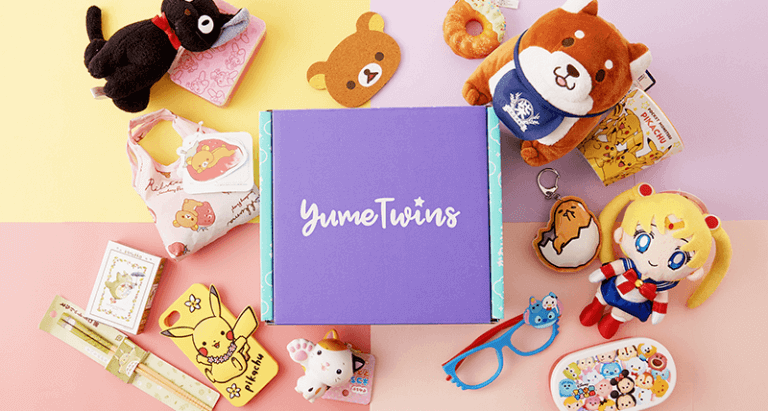Hello Kitty x Japanese Folktale Heroes

Be inspired by a Japanese New Year’s themed item from our YumeTwins January 2022 box lineup, the Hello Kitty Illuminated Crystal Ball. The famous Sanrio mascot appears as characters & personas from Japanese folktales and stories. Learn more about these famous personalities here!

Each character, appearing in stories passed down by generations and beloved by people both young and old, is embedded with a message of positivity and encouragement. Hello Kitty is a master of disguise and can easily pull off just about any look she’s tasked with as well, which she does with aplomb here, just as expected!
Maneki Neko

Symbol of: Good luck, connections, and prosperity
Where: At restaurants & businesses
Features: Holds a coin and raises other paw in a welcoming manner
Details: Generally they’re depicted as calico Japanese Bobtail cats, although different cat breeds may be seen. It’s said that the infamous Meowth character from Pokemon was inspired by the Maneki Neko.
Daruma

Symbol of: Rising above adversity & challenge
Where: Get one from a Buddhist temple to take home
Features: Red in color and made of papier-mâché
Details: The name comes from Bodhidharma, a Buddhist monk who lived 1400 years ago. Daruma eyes are blank. This is to give you time to think of a goal, and you draw in one eye once you decide your goal. The second eye is drawn in once you’ve accomplished said goal.
There’s no need to go far for the best kawaii Japanese goods! YumeTwins sends them straight from Japan to your door each month!

Inu Haruko

Symbol of: Safe childbirth and protecting children
Where: Decorates homes and nurseries
Features: They carry a ‘dendendaiko’ drum on their backs, a traditional toy used to calm babies.
Details: Crafted in the same papier-mâché method as Daruma, these charms are made in the shape of dogs, as they’ve been considered guardians of the home & family since the Edo period (1603-1867).
Shichifukujin

Symbol of: Good luck and happiness
Where: Special shrines & temples dedicated to the Shichifukujin throughout Japan
Features: Often depicted together on a treasure ship called the ‘Takarabune’ in a lighthearted mood.
Details: ‘Shichifukujin’ means ‘Seven Gods of Good Fortune’, and this group of deities is well-known and extremely popular. They sail to the human realm on the first three days of New Year celebrations to bring blessings along the way. Originally from Buddhism, Taoism, and local Japanese origin, they’re all now revered as a single unit.
Shigaraki Tanuki

Symbol of: Joy, good luck, and fortune
Where: Displayed outside homes, restaurants and shrines
Features: Wears a straw hat and carries a bottle of sake
Details: The tanuki, also known as the Japanese raccoon dog, is depicted in Japanese folklore as mischievous & clever, yet fun-loving and easily distracted. A play on the name ‘tanuki’, ‘ta’ means ‘others’ and ‘nuki’ means ‘to surpass’, which is why spotting a tanuki in the wild means your goals will be supported.
Cherry Blossoms

Symbol of: Hope & new beginnings
Where: Mainly in Japan & East Asia
Features: Seen in varying shades of pink & white; some varieties have up to 50 petals per flower.
Details: When this popular symbol of Japan blooms in spring, they have a short stay of about two weeks. This fragility is meant to remind onlookers of life’s delicateness.
And there you have it! Did you know any of these characters or personalities beforehand? Or are there any that particularly stand out to you? Additionally, do you notice any similarities between folktales from your own country and these? Let us know in the comments below!
Related Articles

Harajuku: Where to Find Kawaii Fun!
Kawaii culture is a must-mention part of Japan’s charm, and Harajuku is one of the cradles and most iconic centers of this unique style. When you visit this area, you’ll be amazed by the many options to experience the cuteness fully. Let’s spotlight some of the cutest Harajuku places you want to snap and share!...

The Ultimate Sakura Party: Sweet Flowers, Fashion & More
Spring is the perfect time to step out and enjoy life’s little surprises! If you’re in Japan right now, you might wonder where to gather with your friends and what to wear in this crisp spring weather. Let’s explore kawaii fashion trends and find spots to enjoy sweet flowers! We’ll also uncover attractions that create...

Japanese School Uniforms: What Makes Them Unique?
Japanese school uniforms are as iconic as magical girl outfits or superhero suits.

Animal Crossing: Events in the Spring!
As spring blossoms, Animal Crossing transforms into a charming wonderland that captures the hearts of players everywhere.

Cherry Blossom Trees and Adventure!
Cherry blossom trees hold a special place in Japanese culture. They symbolize beauty, renewal, and the fleeting nature of life. These delicate pink and white flowers bloom briefly each spring, creating breathtaking scenery that attracts visitors worldwide. The cultural significance of these flowers extends beyond nature, influencing traditions, festivals, and even anime!

Shiba Inu Puppy Paradise: The Ultimate Guide!
A Shiba Inu puppy is a tiny ball of fluff with a big personality! Their expressive faces, fox-like ears, and curly tails make them one of the most recognizable dog breeds in the world. If you’re considering bringing a Shiba Inu into your life or just love learning about these fluffy wonders, this guide will...



